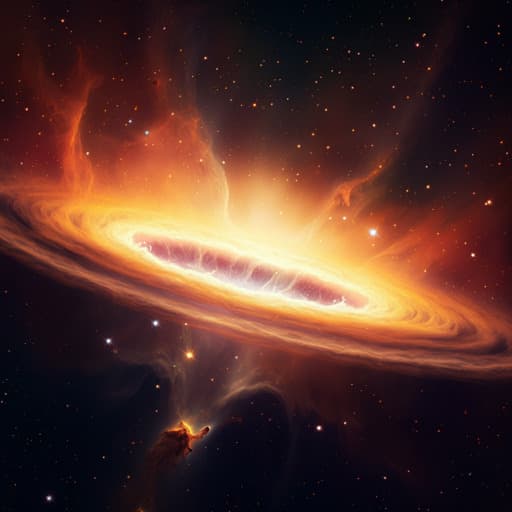
Physics
First emergence of cold accretion and supermassive star formation in the early universe
M. Kiyuna, T. Hosokawa, et al.
This groundbreaking research by Masaki Kiyuna, Takashi Hosokawa, and Sunmyon Chon delves into the early universe’s cold accretion phenomenon. Using advanced simulations, they reveal vital insights into halo formations and the conditions fostering supermassive star formation, making this study essential for understanding cosmic evolution.
~3 min • Beginner • English
Introduction
Observations of >200 quasars at z > 6 imply the presence of ~10^8–10^10 M⊙ supermassive black holes (SMBHs) within the first ~0.7 Gyr of cosmic history, posing challenges for early SMBH formation. Population III (Pop III) remnants are potential seeds but require sustained Eddington accretion, which is difficult due to feedback. The direct collapse (DC) scenario posits that supermassive stars (SMSs; ~10^4–10^6 M⊙) form in atomic cooling halos (ACHs; M_halo ~10^7–10^8 M⊙) where H2 cooling is suppressed, yielding heavy black hole seeds. A key uncertainty is whether cold (penetrating) accretion develops early enough in small halos to generate dense shocks that suppress H2 via collisional dissociation (Zone of No Return, ZoNR) and trigger SMS formation. Prior results are mixed regarding cold-flow penetration in ACHs. This study aims to determine the minimum halo conditions for the first emergence of cold/penetrating accretion at high redshift and to assess whether such flows can produce dense shocks sufficient for SMS formation.
Literature Review
- Pop III star formation and remnant BH growth at high-z have been widely studied; typical Pop III stellar masses range ~10–10^3 M⊙, but their feedback hampers rapid BH growth.
- Direct collapse scenario: SMSs can form in ACHs if H2 cooling is suppressed, classically by strong far-UV Lyman-Werner fields (J21 ≳ 10^3), or via alternative mechanisms (mergers, streaming velocities) that delay star formation until atomic cooling dominates, enabling high accretion rates (~0.1–1 M⊙/yr).
- Collisional dissociation in dense shocks (ZoNR: n_H ≳ 10^4 cm^-3, T ≳ 5000 K) provides another H2-suppression channel (Inayoshi & Omukai), potentially realized in protogalactic collisions, streaming motions, or cold accretion.
- Cold vs hot accretion: At lower redshift and higher halo mass, filamentary cold flows can penetrate halos (Birnboim & Dekel; Kereš et al.; Dekel et al.). In small high-z halos, outcomes differ across simulations: penetration found (Wise & Abel 2007; Greif et al. 2008; Latif et al. 2022) vs. virialization at halo surface (Fernandez et al. 2014).
- Spherical stability analyses (Birnboim & Dekel 2003) relate penetration to cooling vs. dynamical timescales, but their critical masses for low-z massive halos may not directly translate to early small halos where cooling curves peak near 10^4 K.
These studies motivate a dedicated assessment of the conditions for first penetration in ACHs and the SMS-formation potential of the resulting shocks.
Methodology
- Code and setup: Cosmological N-body + SPH simulations with GADGET-3. Initial conditions via MUSIC at z=99 in a (1 h^-1 cMpc)^3 volume. Three realizations identify the most massive halos (A, B, C) at z~10 (M_halo ~10^8 M⊙) using Rockstar.
- Zoom-in runs: Centered on each target halo within a (0.4 h^-1 Mpc)^3 region. Effective (1024)^3 DM and gas particles in the zoom with mass resolutions: m_DM ≈ 68.1 h^-1 M⊙, m_gas ≈ 11.6 h^-1 M⊙. Achieved spatial resolution down to ~1 pc scales near centers. Cosmology: Planck 2013 parameters (Ω_m=0.3086, Ω_Λ=0.6914, Ω_b=0.045, h=0.6777, σ8=0.8288, n_s=0.9611).
- Microphysics: Non-equilibrium chemistry network for five species (e−, H, H+, H2, H−) with 20 reactions; include heating/cooling from chemistry, Lyman-α, and H2 line cooling.
- Radiation background: Uniform Lyman–Werner background J21=10 (sufficient to suppress Pop III in minihalos; lower than the J21~10^3 usually required for FUV-only SMS formation).
- Sink particles: Implemented to follow long-term evolution after initial cloud collapse while controlling computational cost. Sinks are inserted when n_H ≥ 2×10^6 cm^-3; equation of state made adiabatic for n_H ≥ 10^6 cm^-3 to avoid artificial fragmentation. Sinks accrete gas within a radius ~2–3 pc (0.002–0.006 r_vir). Feedback from sinks (radiative/mechanical, metals) is neglected.
- Resolution/Jeans criterion: Jeans mass resolved by ≥80 particles up to densities relevant for ZoNR (n_H ~10^4 cm^-3 at T~5000 K). Self-shielding of H2 is omitted; this affects low-T gas but not ZoNR behavior.
- Shock/flow diagnostics: Define a fast component by infall velocities v_inf > v_vir. Compute radial profiles of total accretion rate and fast-component accretion rate. The representative shock radius r_shock is the innermost radius where fast accretion rate falls below 0.1×the analytic typical halo accretion rate. Time sampling Δt ~ 2.3 Myr.
- Semi-analytic modeling: Start from Birnboim & Dekel’s spherical shock stability criterion (compare t_cool vs. t_dyn), then modify pre-shock density/temperature using filament properties measured at r~r_vir in simulations to better reflect non-spherical filamentary inflow (finite Mach numbers). Derive critical halo masses for penetration as a function of redshift.
- SMS prospects: Identify gas expected to enter ZoNR by applying Rankine–Hugoniot jump conditions to the fast component (v_inf > c_s) to estimate post-shock states. Compare instantaneous mass in ZoNR to the Jeans mass at T~8000 K and n_H~10^4–10^5 cm^-3. Explore dependence on sink radius via runs with different sink thresholds.
Key Findings
- First-penetration threshold: Across halos A, B, and C, the accretion flow transitions from stalling near ~0.5 r_vir to penetrating to ≲0.01 r_vir when the halo reaches a virial temperature T_vir ≈ 1.1×10^4 K. This corresponds to a minimum halo mass for penetration of M_halo,min ≈ 2.2×10^7 M⊙ × [(1+z)/15]^(-3/2).
- Timescales: Penetration typically occurs ~10–30 Myr after the first runaway collapse within the ACH.
- Flow geometry and impact: Penetrating (fast) flows are filamentary and ultimately impact a compact central disc of radius ~0.05 r_vir, generating extended dense shocks across the disc surface. In these small halos, gas throughout the ACH remains near ~8000–10^4 K due to strong Lyα cooling, so the “cold” flow is better described as “penetrating/supersonic” relative to the background.
- Dense shock conditions (ZoNR): Post-shock gas frequently enters the Zone of No Return (n_H ≳ 10^4 cm^-3, T ≳ 5000 K). Instantaneous mass in ZoNR often reaches ~10^4–10^5 M⊙, comparable to the Jeans mass at T~8000 K, n_H~10^4–10^5 cm^-3, enabling gravitational instability and potential SMS formation.
- Semi-analytic consistency: The classical spherical model yields M_crit ≈ 7.6×10^7 M⊙ × [(1+z)/15]^(-3/2) (T_vir ~2.6×10^4 K). Incorporating filamentary pre-shock conditions measured in the simulations reduces this to M_crit ≈ 2.9×10^7 M⊙ × [(1+z)/15]^(-3/2) with T_vir ~1.1×10^4 K, in excellent agreement with the simulations and prior reports of penetration in similar-mass halos.
- Robustness across cases: Halos A, B, and C exhibit the same qualitative behavior: once T_vir ≳ 10^4 K, fast flows routinely reach ~0.01 r_vir and produce ZoNR-eligible post-shock gas concentrated within the central disc radius.
- Sensitivity to sink size: Larger sink radii can mask inner shocked regions and reduce the inferred ZoNR mass; smaller sinks reveal more ZoNR gas, implying our estimates are conservative given resolution and sink limitations.
Discussion
The work demonstrates that in ACHs at z~10–20, once halos cross T_vir~1.1×10^4 K, filamentary, supersonic inflows penetrate to the nucleus and shock against a compact disc, frequently producing dense, hot post-shock gas in the ZoNR. This addresses the research question by identifying clear physical criteria (T_vir and M_halo as functions of redshift) for first penetration and by showing that the resulting shocks can amass gas with mass comparable to the Jeans mass, a necessary condition for collapse into SMSs. The modified semi-analytic framework reconciles earlier discrepancies by accounting for filamentary pre-shock conditions, aligning theory with simulations. Comparisons with prior studies (Wise & Abel; Greif et al.; Fernandez et al.; Latif et al.) suggest differences mainly arise from halo evolutionary stage, numerical method, and analysis definitions. The study further discusses the likely survival of filamentary inflows under UV and SN feedback near/above the atomic-cooling threshold, potential effects of metal enrichment on fragmentation, angular momentum transport requirements for SMS formation, and implications for subsequent BH growth. An order-of-magnitude estimate of occurrence rates indicates that this channel could produce seed BHs at a rate compatible with the observed space density of the most luminous z>6 quasars, subject to uncertainties in feedback and metal enrichment histories.
Conclusion
- Cold/penetrating accretion in early ACHs first emerges when halos exceed M_halo,min ≈ 2.2×10^7 M⊙ × [(1+z)/15]^(-3/2), or T_vir ≈ 1.1×10^4 K. After this transition, shock radii rapidly move inward from ~0.1 r_vir to ~0.01 r_vir as fast flows reach the center.
- Penetrating flows impact a ~0.05 r_vir disc and generate dense shocks. Post-shock gas regularly attains ZoNR conditions, and the instantaneous ZoNR mass reaches ~10^4–10^5 M⊙, comparable to the Jeans mass, supporting the feasibility of SMS formation via collisional H2 dissociation.
- A semi-analytic model incorporating filamentary pre-shock conditions reproduces the simulation threshold (T_vir~1.1×10^4 K), improving upon spherical predictions.
- While simulations omit stellar/BH feedback and metal enrichment, the results suggest cold inflows can trigger conditions necessary for SMS formation shortly after ACHs cross the atomic-cooling threshold. Future high-resolution simulations including radiative, mechanical, and chemical feedback are needed to follow collapse, fragmentation, angular momentum transport, and the fate of the shocked gas to confirm SMS formation and quantify seed BH growth.
Limitations
- Physical processes omitted: no radiative feedback from stars or accreting BHs, no mechanical feedback, and no metal enrichment; these can affect disc structure, inflow survival, thermal/chemical states, and fragmentation.
- Sink particle treatment: finite sink radius (few pc) can mask inner shocks; ZoNR mass is sensitive to sink size and likely underestimated; convergence with smaller sinks/higher resolution is not demonstrated.
- Chemistry/radiation: H2 self-shielding is neglected, affecting low-temperature gas (though ZoNR post-shock evolution is argued to be insensitive). Uniform LW background (J21=10) is assumed; local radiation sources are ignored.
- Resolution: SPH resolution may not fully resolve post-shock cooling layers and turbulence; standard SPH limitations in capturing fluid instabilities may affect flow morphology relative to AMR/moving-mesh methods.
- Semi-analytic approximations: Filamentary pre-shock properties are estimated from simulations at r_vir and applied globally; strong-shock assumptions are relaxed but still approximate.
- Timing and occurrence rate estimates carry uncertainties in merger rates, metal-free fractions, and feedback-driven delays.
Related Publications
Explore these studies to deepen your understanding of the subject.







